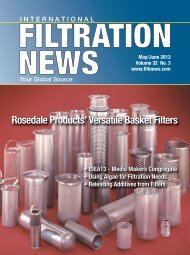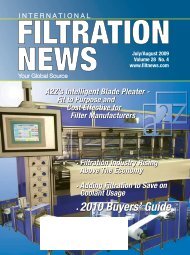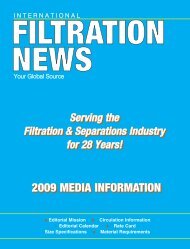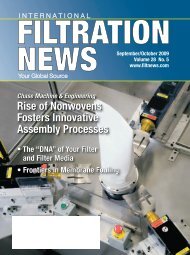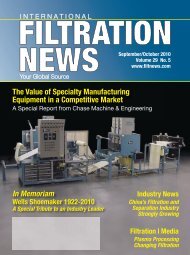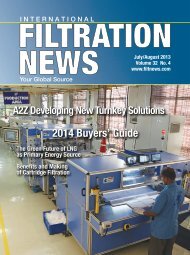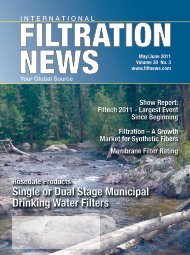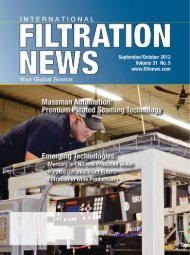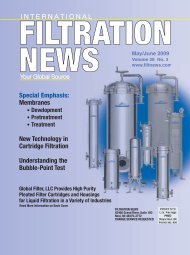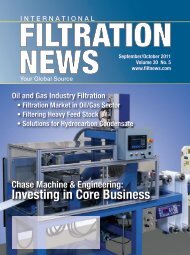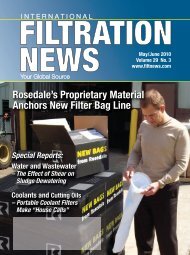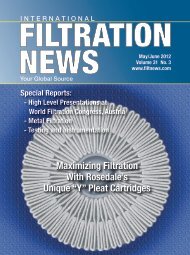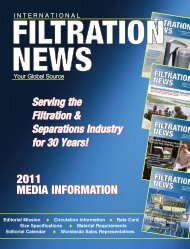2011 Buyers' Guide 2011 Buyers' Guide - International Fiber Journal
2011 Buyers' Guide 2011 Buyers' Guide - International Fiber Journal
2011 Buyers' Guide 2011 Buyers' Guide - International Fiber Journal
- No tags were found...
You also want an ePaper? Increase the reach of your titles
YUMPU automatically turns print PDFs into web optimized ePapers that Google loves.
Trends | FiltrationMercury Removal Media: Mercury(Hg) reduction has been an enigma toregulators, the general public and producersof media and process facilitiesalike. Many materials and processes havebeen tried to solve this vexing problem.To date, the preferred materials have beenactivated carbon, but because of overallefficiency limitations along with reprocessingand waste disposal issues, usersand environmental regulators continue toseek improved solutions. Now, a newmedia and system reports success at 100percent efficiency in very large-scale naturalgas processes with the ability to concentratemercury and completelyeliminate media waste, regeneration andhazmat disposal. In time this technologylikely will be developed to work withcoal-fired power plants and cement factories,the two largest mercury emitters.Coalescing media has proven capabilities for removing oil from water and oilymist from air at levels heretofore not achievable by other media.definition, but mostly shades of gray.There are certain new developmentsand emerging technologies worth commentingon. The developments describedbelow revolve around filtrationmedia and new filter, equipment orprocess design.NEW FILTRATION MEDIAHEPA Media: Wetlaid glass filtrationmedia has been the preferred inHEPA air filtration in semiconductorcleanrooms, laboratories, surgical operatingtheaters, pharmaceutical manufacturing,and in the production ofLCD screens. Over the years, endusersat semiconductor manufacturingcompanies have sought an alternativemedia to glass to reduce off-gassingand wafer contamination. Alternativemedia such as PTFE membranes havebeen used, but the cost remains ashortcoming, limiting its use. Now, anew nonwoven filter media with extremelyfine polymeric fibers is increasinglycapturing a portion of themarket at a cost comparable to wetlaidglass media has dominated.8 • August 2010 • www.filtnews.comNanofibers and Nano Media: By lastcount there were over 30 companies eitherdeveloping or in commercial productionwith nanofiber or webs, yet fewwill ever achieve meaningful sales success.Too many media manufacturers areenthralled with the ability to makenanofiber materials without an understandingof the performance requirementsof the markets and customers.With that said there are suppliers whohave created winning constructions, primarilyfor air filtration. Only one companyhas fully commercialized ananofiber for liquid filtration, made froma combination of boehmite and glass,which works via electro-adsorbitive andion exchange properties, not mechanicalfiltration. A second company has productsin development from all commodityand specialty polymers, processableinto nanofiber in most nonwoven formatsfor air and liquid at substantiallygreater speed than electrospinning.ADVANCED FILTER CAPABILITIESCoalescing Separators: Coalescingmedia has traditionally used glass fiberand other materials such as E-CTFE fluoropolymernonwoven as the media ofchoice and state-of-the-art. For advancedseparations for challenging separations anew medium has emerged as a worthychallenger. The patented material consistsof a viscoelastic polymer, which is



